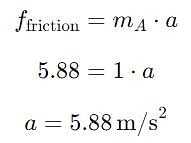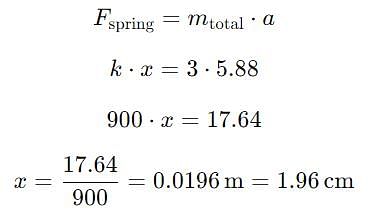JEE Exam > JEE Questions > In the arrangement shown coefficient of frict...
Start Learning for Free
In the arrangement shown coefficient of friction between the two blocks A and B is 0.6 and ground is frictionless. Force constant of spring is 900 N/m. Find the maximum elongation of spring (in cm) such that the blocks do not slip over each other when released.


Correct answer is '1'. Can you explain this answer?
| FREE This question is part of | Download PDF Attempt this Test |
Most Upvoted Answer
In the arrangement shown coefficient of friction between the two block...
Frictional Force Between the Blocks: The frictional force between the two blocks can be calculated using the formula:
ffriction = μ ⋅ N
Where:
ffriction = μ ⋅ N
Where:
- μ = 0.6 is the coefficient of friction.
- N is the normal force, which is equal to the weight of block A.
For block A (1 kg):
N = mA ⋅ g = 1⋅9.8 = 9.8N
Now, calculate the maximum frictional force:
Maximum Acceleration Without Slipping: The maximum force that can be applied to block A without it slipping over block B is the frictional force we calculated. This force will cause an acceleration in both blocks (since they are stacked together).
Using Newton’s second law:

N = mA ⋅ g = 1⋅9.8 = 9.8N
Now, calculate the maximum frictional force:
f
friction
= 0.6⋅9.8 = 5.88 NMaximum Acceleration Without Slipping: The maximum force that can be applied to block A without it slipping over block B is the frictional force we calculated. This force will cause an acceleration in both blocks (since they are stacked together).
Using Newton’s second law:

This is the maximum acceleration the system can have without the blocks slipping over each other.
Force on the System Due to Spring: The spring exerts a restoring force given by Hooke’s law:
Fspring = k ⋅ x
Where:
Force on the System Due to Spring: The spring exerts a restoring force given by Hooke’s law:
Fspring = k ⋅ x
Where:
- k = 900 N/m is the spring constant.
- x is the elongation in the spring.
This spring force will accelerate both blocks together, so the total mass being accelerated is:

Applying Newton’s second law for the whole system:

The maximum elongation of the spring such that the blocks do not slip over each other is approximately 1 cm (rounded to the nearest whole number).

Applying Newton’s second law for the whole system:

The maximum elongation of the spring such that the blocks do not slip over each other is approximately 1 cm (rounded to the nearest whole number).
Attention JEE Students!
To make sure you are not studying endlessly, EduRev has designed JEE study material, with Structured Courses, Videos, & Test Series. Plus get personalized analysis, doubt solving and improvement plans to achieve a great score in JEE.

|
Explore Courses for JEE exam
|

|
Similar JEE Doubts
In the arrangement shown coefficient of friction between the two blocks A and B is 0.6 and ground is frictionless. Force constant of spring is 900 N/m. Find the maximum elongation of spring (in cm) such that the blocks do not slip over each other when released.Correct answer is '1'. Can you explain this answer?
Question Description
In the arrangement shown coefficient of friction between the two blocks A and B is 0.6 and ground is frictionless. Force constant of spring is 900 N/m. Find the maximum elongation of spring (in cm) such that the blocks do not slip over each other when released.Correct answer is '1'. Can you explain this answer? for JEE 2024 is part of JEE preparation. The Question and answers have been prepared according to the JEE exam syllabus. Information about In the arrangement shown coefficient of friction between the two blocks A and B is 0.6 and ground is frictionless. Force constant of spring is 900 N/m. Find the maximum elongation of spring (in cm) such that the blocks do not slip over each other when released.Correct answer is '1'. Can you explain this answer? covers all topics & solutions for JEE 2024 Exam. Find important definitions, questions, meanings, examples, exercises and tests below for In the arrangement shown coefficient of friction between the two blocks A and B is 0.6 and ground is frictionless. Force constant of spring is 900 N/m. Find the maximum elongation of spring (in cm) such that the blocks do not slip over each other when released.Correct answer is '1'. Can you explain this answer?.
In the arrangement shown coefficient of friction between the two blocks A and B is 0.6 and ground is frictionless. Force constant of spring is 900 N/m. Find the maximum elongation of spring (in cm) such that the blocks do not slip over each other when released.Correct answer is '1'. Can you explain this answer? for JEE 2024 is part of JEE preparation. The Question and answers have been prepared according to the JEE exam syllabus. Information about In the arrangement shown coefficient of friction between the two blocks A and B is 0.6 and ground is frictionless. Force constant of spring is 900 N/m. Find the maximum elongation of spring (in cm) such that the blocks do not slip over each other when released.Correct answer is '1'. Can you explain this answer? covers all topics & solutions for JEE 2024 Exam. Find important definitions, questions, meanings, examples, exercises and tests below for In the arrangement shown coefficient of friction between the two blocks A and B is 0.6 and ground is frictionless. Force constant of spring is 900 N/m. Find the maximum elongation of spring (in cm) such that the blocks do not slip over each other when released.Correct answer is '1'. Can you explain this answer?.
Solutions for In the arrangement shown coefficient of friction between the two blocks A and B is 0.6 and ground is frictionless. Force constant of spring is 900 N/m. Find the maximum elongation of spring (in cm) such that the blocks do not slip over each other when released.Correct answer is '1'. Can you explain this answer? in English & in Hindi are available as part of our courses for JEE.
Download more important topics, notes, lectures and mock test series for JEE Exam by signing up for free.
Here you can find the meaning of In the arrangement shown coefficient of friction between the two blocks A and B is 0.6 and ground is frictionless. Force constant of spring is 900 N/m. Find the maximum elongation of spring (in cm) such that the blocks do not slip over each other when released.Correct answer is '1'. Can you explain this answer? defined & explained in the simplest way possible. Besides giving the explanation of
In the arrangement shown coefficient of friction between the two blocks A and B is 0.6 and ground is frictionless. Force constant of spring is 900 N/m. Find the maximum elongation of spring (in cm) such that the blocks do not slip over each other when released.Correct answer is '1'. Can you explain this answer?, a detailed solution for In the arrangement shown coefficient of friction between the two blocks A and B is 0.6 and ground is frictionless. Force constant of spring is 900 N/m. Find the maximum elongation of spring (in cm) such that the blocks do not slip over each other when released.Correct answer is '1'. Can you explain this answer? has been provided alongside types of In the arrangement shown coefficient of friction between the two blocks A and B is 0.6 and ground is frictionless. Force constant of spring is 900 N/m. Find the maximum elongation of spring (in cm) such that the blocks do not slip over each other when released.Correct answer is '1'. Can you explain this answer? theory, EduRev gives you an
ample number of questions to practice In the arrangement shown coefficient of friction between the two blocks A and B is 0.6 and ground is frictionless. Force constant of spring is 900 N/m. Find the maximum elongation of spring (in cm) such that the blocks do not slip over each other when released.Correct answer is '1'. Can you explain this answer? tests, examples and also practice JEE tests.

|
Explore Courses for JEE exam
|

|
Suggested Free Tests
Signup for Free!
Signup to see your scores go up within 7 days! Learn & Practice with 1000+ FREE Notes, Videos & Tests.
























